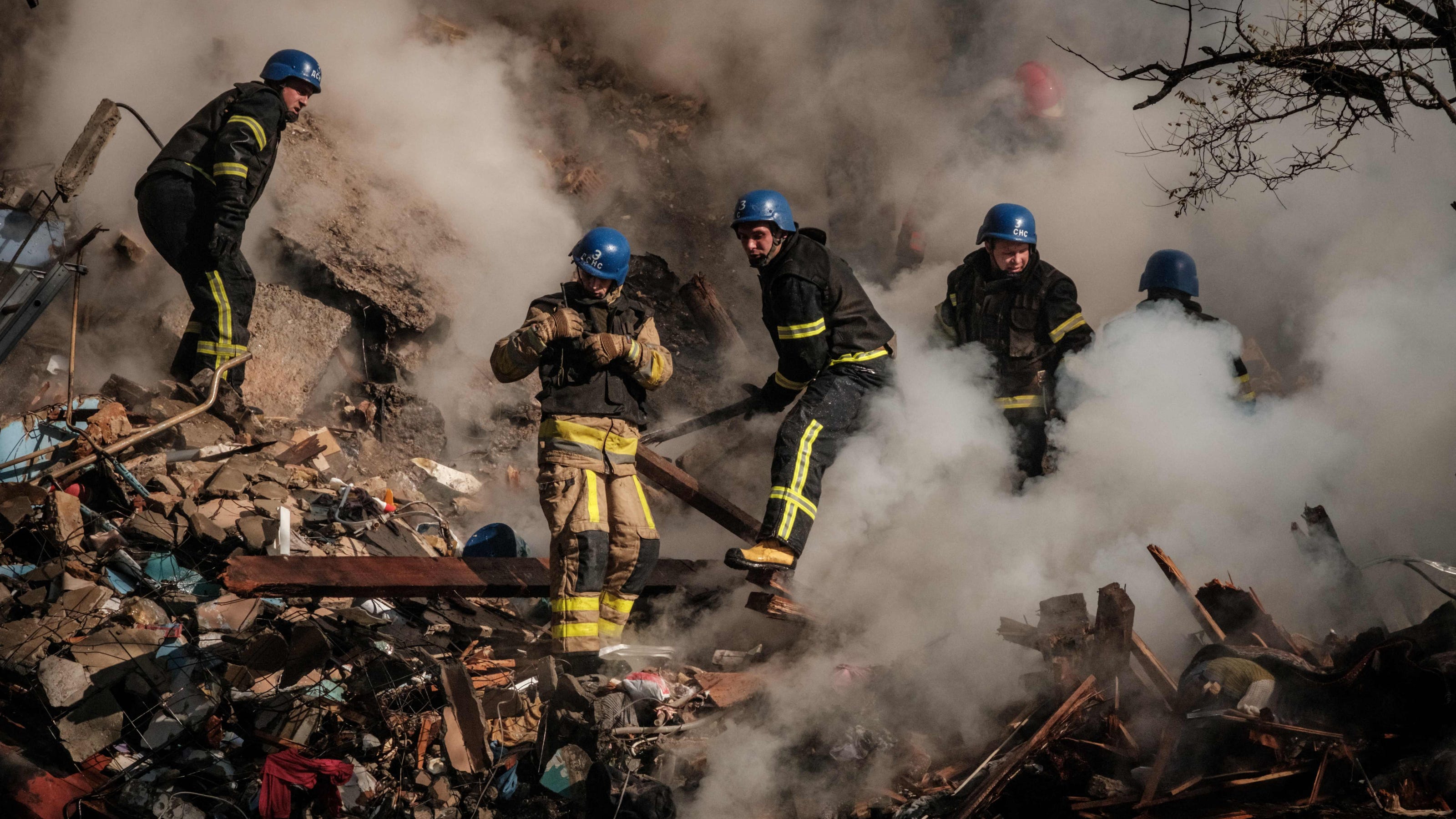Analysis: Russia's Largest Drone Attack On Ukraine And Its Implications

Table of Contents
Scale and Nature of the Attack
Number and Types of Drones
Reports indicate that Russia launched a wave of over 100 drones in this, their largest drone attack on Ukraine to date. While the exact number remains debated and subject to verification, the sheer scale surpasses previous attacks significantly. The majority of drones deployed were reportedly Iranian-made Shahed-136 kamikaze drones, known for their relatively low cost and ease of use. However, other types of UAVs were also allegedly involved, suggesting a multi-faceted approach.
- Specific numbers of drones: Estimates vary, but over 100 drones were launched, according to multiple reports.
- Types of drones used: Primarily Shahed-136 drones, potentially supplemented by other, less-identified models.
- Evidence of Iranian involvement: Reports strongly suggest Iranian involvement in providing the Shahed drones, potentially fueling the conflict further.
- Assessment of drone capabilities: The Shahed-136 drones are effective against softer targets, but their accuracy and effectiveness against hardened military installations is debatable.
Targets of the Attack
The drone attack targeted critical Ukrainian infrastructure, aiming to disrupt essential services and inflict widespread damage. Key targets included power generation facilities, transportation networks, and military installations across multiple regions of Ukraine. While specific locations are still being verified, the widespread nature of the attack suggests a strategic goal of destabilizing the country.
- Specific locations targeted: Power grids in Kyiv, Odesa, and other regions were primarily targeted, along with some military bases.
- Types of damage inflicted: Widespread power outages, disruptions to transportation, and damage to infrastructure were reported.
- Civilian casualties: While military infrastructure was a key target, some civilian areas also suffered damage and casualties are being reported.
- Assessment of strategic importance of targets: The targeting of power infrastructure suggests a desire to cripple Ukraine’s economic activity and civilian resilience.
Timeline and Operational Aspects
The drone attack unfolded over several hours, likely in multiple waves. The attacks appear to have been coordinated and launched from various locations inside Russia and potentially from occupied territories within Ukraine. The timing, coinciding with significant geopolitical events, suggests potential strategic intent.
- Start and end time of the attack: The attack lasted for several hours, spread over a significant time frame.
- Waves of attacks: The attack appears to have been delivered in multiple waves, suggesting a deliberate and sustained effort.
- Duration of the attack: The attack’s extended duration suggests a well-planned and coordinated operation.
- Coordination and tactics used by the Russian forces: The attack demonstrated sophisticated coordination and a reliance on unmanned aerial vehicles for large-scale attacks.
Immediate Impact and Consequences
Damage Assessment
The attack caused substantial damage to Ukraine's energy infrastructure, leading to widespread power outages across multiple regions. The extent of damage to transportation networks, communication systems, and military facilities is still being assessed. Preliminary estimates suggest billions of dollars in damage.
- Estimated cost of damage: Preliminary estimates suggest massive infrastructural losses in the billions.
- Impact on essential services: Power outages and transportation disruptions significantly impacted civilian life and essential services.
- Damage to military assets: The extent of military damage is still under investigation but is expected to be significant in some cases.
Casualties and Humanitarian Impact
Reports indicate a significant number of casualties, both military and civilian. The power outages left many without heating or access to medical care in winter conditions. The displacement of civilians and humanitarian needs, particularly in affected areas, are substantial and growing.
- Number of killed and injured: Reports of casualties are emerging, though precise figures are still uncertain.
- Humanitarian aid needs: Significant humanitarian aid is required to address immediate needs.
- Impact on civilian morale: While initial reports suggest resilience, the repeated attacks could negatively impact morale.
Ukrainian Response and Defense
Ukrainian air defenses demonstrated improved capabilities in intercepting some of the drones, but a significant number still managed to breach defenses. This highlights the challenge posed by large-scale drone attacks and the need for continued investment in air defense systems.
- Percentage of drones intercepted: While a significant number were intercepted, many others reached their targets.
- Effectiveness of different defense systems: Ukrainian air defenses showed varying degrees of effectiveness, needing upgrades to counter future attacks.
- Challenges faced by Ukrainian defenses: The sheer volume of drones and their varied flight paths pose a complex challenge to air defenses.
Strategic and Geopolitical Implications
Russian Objectives
Russia’s large-scale drone attack likely aims to weaken Ukraine's infrastructure, disrupt its military capabilities, and demoralize the civilian population. The attack may also aim to shift the balance of power on the battlefield and influence negotiations, demonstrating Russia's continued military capacity.
- Possible Russian strategic goals: To weaken Ukraine's infrastructure, disrupt supply lines, and demoralize the civilian population.
- Assessment of the attack's effectiveness in achieving those goals: The attack has significantly impacted Ukrainian infrastructure but its long-term strategic impact is yet to be determined.
- The long-term implications: This tactic likely foreshadows future attacks, demanding a response from Ukraine and its allies.
International Response
The international community condemned the attack, highlighting its violations of international humanitarian law and emphasizing the need for accountability. Increased military and humanitarian aid, as well as potential sanctions, are expected responses from Ukraine's allies.
- Statements from NATO, the EU, the US, and other key international players: Widespread condemnation and calls for accountability and support for Ukraine.
- Potential sanctions or other responses: Further sanctions against Russia and increased military and humanitarian aid to Ukraine are likely.
Impact on the War's Trajectory
The drone attack may indicate a shift in Russia's military strategy, highlighting its increased reliance on drones for large-scale attacks. This could influence future military engagements, further complicate negotiations, and impact public opinion both domestically and internationally.
- Potential shifts in military strategies: An increased focus on drone warfare by Russia.
- Implications for negotiations: The attack may create more obstacles for diplomatic solutions to the conflict.
- Impact on public opinion: The attack likely further solidifies international support for Ukraine.
Conclusion
This analysis highlights the unprecedented scale and significance of Russia's largest drone attack on Ukraine. The attack demonstrates a shift in Russian military tactics, showcasing the increasing reliance on drone technology for large-scale attacks. The impact, both immediate and long-term, is considerable, spanning infrastructural damage, humanitarian consequences, and a shift in the geopolitical landscape. The vulnerability of critical infrastructure to such attacks is undeniably demonstrated, prompting serious considerations regarding defensive strategies and the future of urban warfare.
Further research and analysis are crucial for understanding the evolving nature of drone warfare and its implications for future conflicts. Continued monitoring of the situation, as well as in-depth studies of Russia's drone capabilities and Ukraine's defense strategies against these attacks are vital for informed decision-making regarding this escalating conflict. Understanding Russia's use of drones in the Ukraine conflict, and the implications thereof, is paramount for global security. The continued analysis of large-scale drone attacks, like this one, is vital for improving future defense strategies and mitigating the humanitarian crisis.

Featured Posts
-
 East Hampton Officer Luis Morales Facing Dwi Charges Southampton Pd Investigation
May 19, 2025
East Hampton Officer Luis Morales Facing Dwi Charges Southampton Pd Investigation
May 19, 2025 -
 Music Festival Cancellations Court Decision Impacts Parks
May 19, 2025
Music Festival Cancellations Court Decision Impacts Parks
May 19, 2025 -
 Eurovision 2025 Fechas Semifinales Y Datos Clave Del Festival
May 19, 2025
Eurovision 2025 Fechas Semifinales Y Datos Clave Del Festival
May 19, 2025 -
 El Tenis Espanol De Luto Muere Juan Aguilera Ganador De Masters 1000
May 19, 2025
El Tenis Espanol De Luto Muere Juan Aguilera Ganador De Masters 1000
May 19, 2025 -
 Is The Chronology Of Water A Success Analyzing Kristen Stewarts Directorial Debut
May 19, 2025
Is The Chronology Of Water A Success Analyzing Kristen Stewarts Directorial Debut
May 19, 2025
